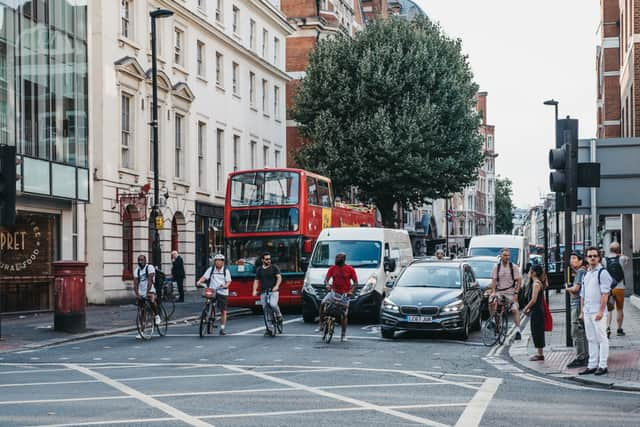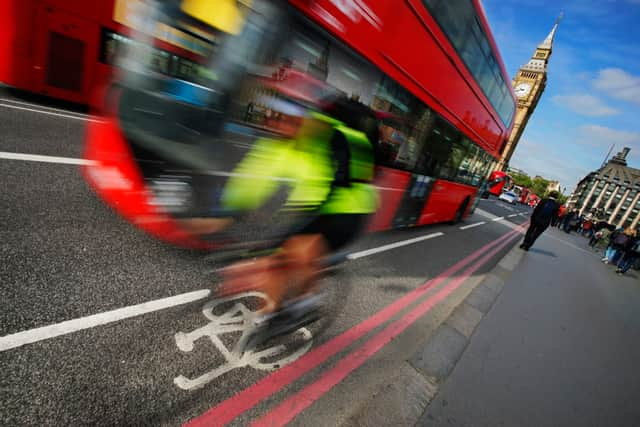Highway Code 2023: latest rules explained as millions still confused about changes


Millions of drivers are still confused by major changes to the Highway Code a year after they were implemented,
A new study of drivers found that in some cases only one in five motorists could correctly identify changes to the road users’ handbook and, despite being more confident, younger drivers were more likely to be confused by the changes.
Advertisement
Hide AdAdvertisement
Hide AdThe Highway Code underwent one of the biggest revisions in decades at the start of 2022, introducing a new hierarchy of road users, updating guidance on who has priority at junctions and introducing official guidance on how to safely overtake slower road users.
The survey of drivers by insurer Aviva, to promote its Quotemehappy Connect app, found that most drivers (63%) understood changes which made it clear that turning vehicles should give way to pedestrians waiting to cross side roads and which road users have priority at roundabouts. But just 16% could identify the recommended speed and gap for overtaking a horse and only 19% correctly picked out the fake recommendation in a list of tips for charging electric vehicles.
It also found that while half of drivers aged 17-24 were most likely to check the Highway Code at least once a year, compared with a quarter of motorists aged 55+, it was the older motorists who understood the rules better. Younger drivers scored an average of five out of 12, when questioned on selected points of the Highway Code, compared to seven out of 12 for the over-55s.
Matthew Washer, head of connected motor at Aviva, said: “There are a wealth of tools and tips available to help motorists drive more safely. However, it’s important that people know the rules of the roads too. This latest research demonstrates that people aren’t always up to speed with the latest Highway Code changes, so we’d encourage them to review their knowledge on a regular basis, so they know how to stick to the rules when behind the wheel.”
In total, the 2022 update brought eight entirely new rules and amended 49 others. Here are the key points all road users should know:
Hierarchy of road users


Rule H1 is completely new and states: “Those in charge of vehicles that can cause the greatest harm in the event of a collision bear the greatest responsibility to take care and reduce the danger they pose to others. This principle applies most strongly to drivers of large goods and passenger vehicles, vans/minibuses, cars/taxis and motorcycles.
“Cyclists, horse riders and drivers of horse drawn vehicles likewise have a responsibility to reduce danger to pedestrians. None of this detracts from the responsibility of ALL road users, including pedestrians, cyclists and horse riders, to have regard for their own and other road users’ safety.”
Priority at junctions
Rule H2 changes the rules around behaviour at junctions and other shared road spaces. It emphasises that drivers, motorcyclists, horse drawn vehicles, horse riders and cyclists “should give way to pedestrians crossing or waiting to cross a road into which or from which you are turning.
Advertisement
Hide AdAdvertisement
Hide Ad“You MUST give way to pedestrians on a zebra crossing, and to pedestrians and cyclists on a parallel crossing.”
It also highlights that horse riders should give way to pedestrians on a zebra crossing, and to pedestrians and cyclists on a parallel crossing, while cyclists should give way to pedestrians on shared routes.
Rule H3 applies to drivers and motorcyclists and states that “you should not cut across cyclists, horse riders or horse drawn vehicles going ahead when you are turning into or out of a junction or changing direction or lane, just as you would not turn across the path of another motor vehicle.”
It also advises drivers to stop and wait for a safe gap when cyclists are approaching or using a junction or roundabout or passing stationary traffic, while updates to rule 186 also emphasise that drivers should give priority to cyclists on the roundabout, leave plenty of room and not overtake them within their own lane.


A change to rule 163 also introduces official guidance on how much space drivers should give when overtaking cyclists and horses. You should give at least as much room as you would when overtaking a car, with the guidance recommending at least 1.5 metres space at speeds of up to 30mph and more space at higher speeds.
Rules for cyclists
Several new rules apply specifically to cyclists, replacing or significantly altering existing rules.
Updates include advice on high-visibility clothing and the use of helmets as well as detailing the different types of cycle routes, lanes and tracks.
Rule 63 is an entirely new rule that emphasises that cyclists should take care and slow down when passing pedestrians, horse riders or horse drawn vehicles on shared routes. They should also let other users know they are there.
Advertisement
Hide AdAdvertisement
Hide AdRule 72 is also new and sets out two basic road positions cyclists should adopt, depending on the situation. These are:
- Ride in the centre of your lane, to make yourself as clearly visible as possible on quiet roads, in slow moving traffic and on the approach to junctions, while allowing vehicles to overtake when safe.
- When riding on busy roads, with vehicles moving faster than you, allow them to overtake where it is safe to do so whilst keeping at least 0.5 metres away from the kerb edge.
New Rule 73 covers how cyclists use junctions. It recommends using special cycle facilities such as advanced stop lines at any junction that has them and, at junctions without them, proceeding as if they were driving a motor vehicle by positioning themselves in the middle o the lane.
Rule 75 is also completely new and relates to using two-stage turns which allow cyclists to move separately from other traffic to make right-hand turns.
New Rule 76 highlights that cyclists travelling straight ahead at a junction now have priority over traffic waiting to turn into or out of the side road, unless road signs or markings indicate otherwise.
Comments
Want to join the conversation? Please or to comment on this article.
